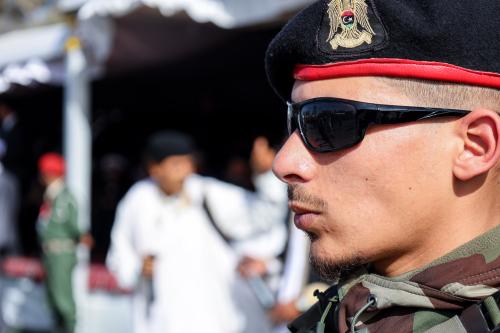Washington is a town always concerned with who is on the up and who is on the down. So it is no surprise that, while the dust has not yet settled from the final stages of the military campaign in Afghanistan, already budget battlelines are being drawn. So just how does Enduring Freedom appear to shake out for each of the military branches?
Air Force: For the bluesuiters, the victory over the Taliban could be viewed as a vindication of power from above. The reality, however, is that the campaign raised a number of questions that will be debated long and hard. The attacks carried out by long-range American heavy bombers proved critical in cracking Taliban frontlines. However, air strikes carried out in isolation are still not sufficient to defeat a resistant adversary, even one that cedes its own airspace. After starting out with a fairly unimaginative doctrine that followed the old playbook, air power only became successful when integrated with the strange combination of Northern Alliance cavalry and US Special Forces ground spotters.
More interesting is that once again it was the almost half-century old B-52 that did much of the heavy lifting. The future model of air campaigns will likely be similar. The newer, stealthy planes, like the B-2 and F-22, will serve as the tip of the spear that cracks adversaries’ air defenses, allowing the rest of the force to exploit American control over airspace. The dilemma this presents for air warriors is that, while it requires continuing development of the most hi-tech planes, it does not necessitate massive purchasing to overhaul the entire force. The campaign also once more showed the importance of support aircraft, such as transport and refueling planes, that are certainly less sexy than the newest fighter jets, but deserve equal priority in purchasing. Finally, the arming of unmanned aerial vehicles raises all sorts of intriguing implications. Now that another line in automated aerial warfare has been crossed, we will likely see a manned-unmanned budget battle down the road.
Army: Perhaps only matched by the Air Force, the results so far from Enduring Freedom present the Army with the greatest future challenges. The operations in Central Asia were one more conflict where the Army’s heavy forces could not make it to the fight, even if they had been needed. Instead, it was light, air transportable forces, such as the 10th Mountain Division and most particularly Special Forces teams, that were able to deploy quickly and participate in operations. This campaign will surely give further support to the calls for alterations in the force mix. The utility of purchasing new weapons systems that cannot be deployed for unexpected contingencies, such as the Crusader artillery system, will also be challenged.
As the war on terrorism continues worldwide, the Special Operations Forces (primarily Army-based) will gain the biggest budget punch. More importantly, they will likely gain new autonomy in their operations. Indications are that the Special Operations Command may gain control over the overall global war on terror, licensed to cross over into the domain of regional based CINCs. Both changes will certainly raise existing tensions with more traditional land warriors.
Marines: For the Leathernecks, the opening rounds of Enduring Freedom had been far from satisfying; that is, until their leapfrog deployment to Forward Operating Base Rhino outside Khandahar. While champing at the bit to get a piece of the action, their activities primarily were limited to backup support for the other forces. However, the soldiers from the sea remained on the scene and ready to go. The result was that as the situation developed, they were able quickly to deploy and set up a valuable base of operations in the south of Afghanistan.
While the Kandahar deployment may have garnered most of the recent headlines, the operations in Afghanistan seem unlikely to have any major budget implications for the Corps. The demand for a long-range aircraft capable of inserting troops was likely bolstered, but the status of this budget line item depends more on resolution of the V-22 Osprey’s technical problems than anything else. Likewise, it was instead on the domestic front where the Marines demonstrated why they are considered the savviest service when it comes to the budget. The activation of 4th Marine Expeditionary Brigade, as an antiterrorist force suited for the new demands of homeland defense, once again kept the Marines ahead of the game.
Navy: For the Navy, Enduring Freedom was an operation of redemption. After playing a lesser role in campaigns in the Gulf and the Balkans, aircraft carriers proved their utility in projecting US power to areas where base access was limited. Navy planes carried out the majority of American airstrikes and influenced a primarily land war. The next time anyone thinks of calling for the replacement of flattops, they can expect to hear this line repeated over and over again.
Carriers are still large platforms, increasingly vulnerable to modern weaponry. Fortunately enough, few adversaries have capacity to threaten them. The disadvantages are outweighed by the reward of having ready and deployable American strike planes, not needing prior coalition approval.
The overall news from Enduring Freedom is that American military services in general are certainly on the ups. Once again, it did our nation proud. Hopefully, the results from the next budget battle will as well. Now is not the time to protect old bases, pork barrel projects, or legacy weapons programs. Congress should reward the individual services in a manner that leaves them best prepared for the wars of the future, not the past.



Commentary
Op-edWho’s the Big Winner? All Services Likely to Reap Rewards
December 18, 2001